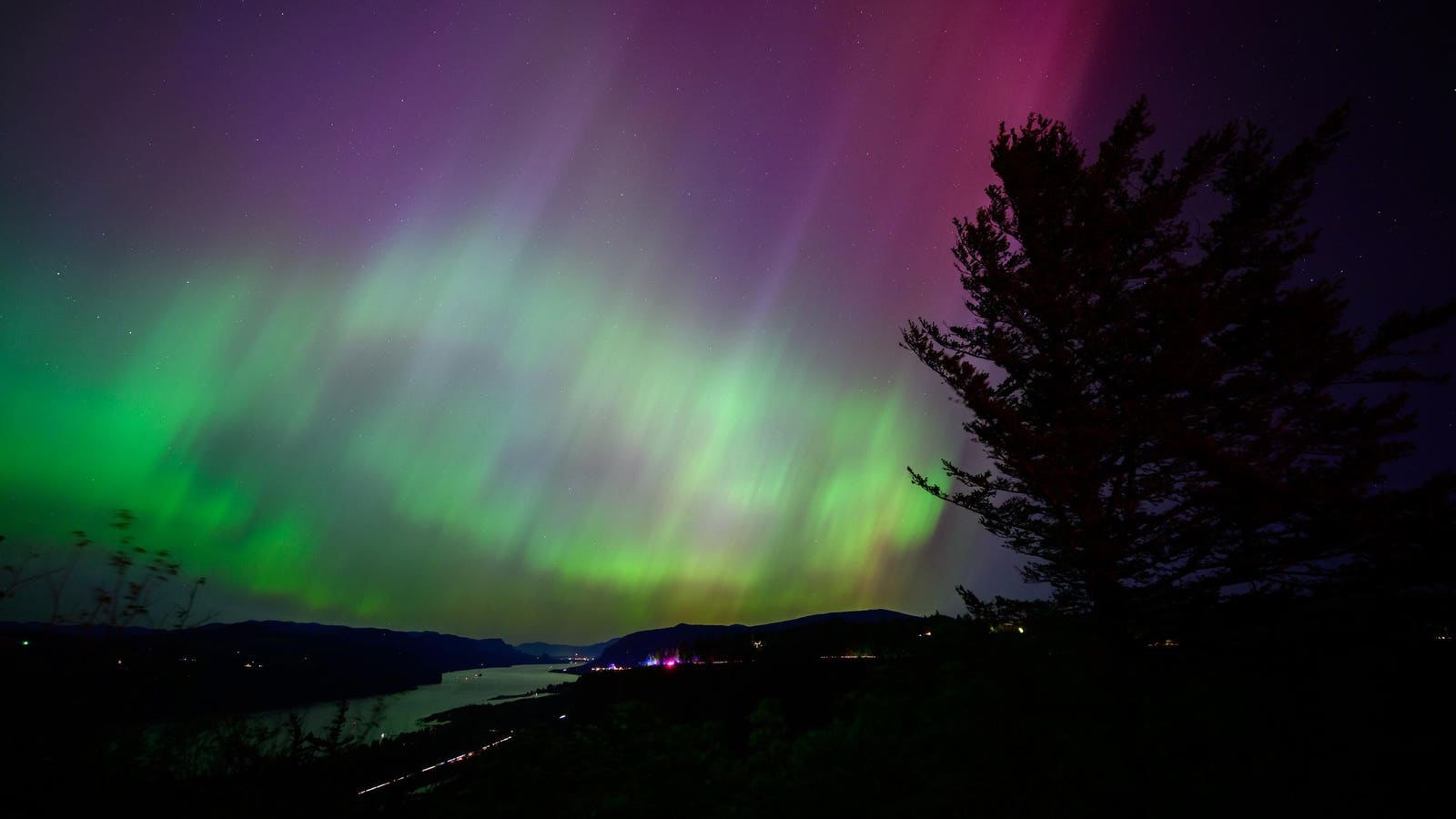Topline
The Northern Lights may be glimpsed this Friday, May 9, in the continental U.S. after space weather forecasters predicted favorable geomagnetic storm conditions. It comes almost exactly a year after an extreme G5 geomagnetic storm on May 10-11, 2024, the most severe in the past two decades and maybe for hundreds of years.
The Northern Lights are seen above the Columbia River Gorge from Chanticleer Point Lookout in the … More early morning hours of May 11, 2024 in Latourell, Oregon. The Northern Lights may be seen this week in the continental U.S. after space weather forecasters predicted favorable geomagnetic storm conditions. (Photo by Mathieu Lewis-Rolland/Getty Images)
Key Facts
The National Oceanic and Atmospheric Administration’s Space Weather Prediction Center’s forecast has a G1-rated geomagnetic storm arriving late on May 9. It comes in the wake of the biggest sunspot of 2025.
Those under clear, dark skies away from light pollution may see the glow of the aurora borealis low on the northern horizon from 11 U.S. states though a bright waxing gibbous moon may make sightings more difficult. The flower moon will turn full on Monday, May 12.
A G1 geomagnetic storm is being forecast, though that’s a prediction — it could, in practice, turn out to be either a weaker display or a stronger G2 geomagnetic storm. During G1 storms, aurora is commonly visible at high latitudes — such as northern Michigan and Maine — according to NOAA, while G2 storms are generally seen as far south as New York and Idaho.
U.S. states where aurora could be glimpsed in the north include Alaska, northeastern Washington, northern Montana, North Dakota, northern Minnesota and northern Michigan, while a smaller chance exists for northern Idaho, South Dakota, Wisconsin, northern Wyoming and northern Maine.
How Strong The Northern Lights Will Be
The predicted displays of aurora borealis have predicted Kp index of 4.67. The Kp index is an imperfect measure of how far from the poles the aurora oval reaches. According to NOAA, during a Kp 3-5 display, “the aurora will move further from the poles, it will become brighter, and there will be more auroral activity (motion and formations). If you are in the right place, these aurora can be quite pleasing to look at.”
Space weather is unpredictable and the forecast can change quickly. Skywatchers are advised to check NOAA’s aurora view line, which is available for tonight and tomorrow night, and its 30-minute forecast and X account, where the latest forecasts are posted.
What Causes The Northern Lights
The Northern Lights are caused by the solar, a stream of charged particles from the sun that interacts with Earth’s magnetic field. As charged particles strike Earth’s magnetic field, they accelerate down its magnetic field lines at the north and south poles, exciting particles in the atmosphere to create ovals of green and red.
Aurora is typically seen in polar regions at around latitudes of 70 degrees north and south, but during strong geomagnetic conditions the auroral oval can bulge, with displays then seen as far as 40 degrees north and south. Solar activity is currently at a 23-year high.
Further Reading
ForbesNASA Urges Public To Look At Night Sky Now For ‘Nova’ LocationBy Jamie CarterForbesFull Moon May 2025: When To See The ‘Flower Moon’ Rise Where You AreBy Jamie Carter
ForbesIn Photos: Giant Sunspot Appears On The Sun — How To Safely See ItBy Jamie Carter










